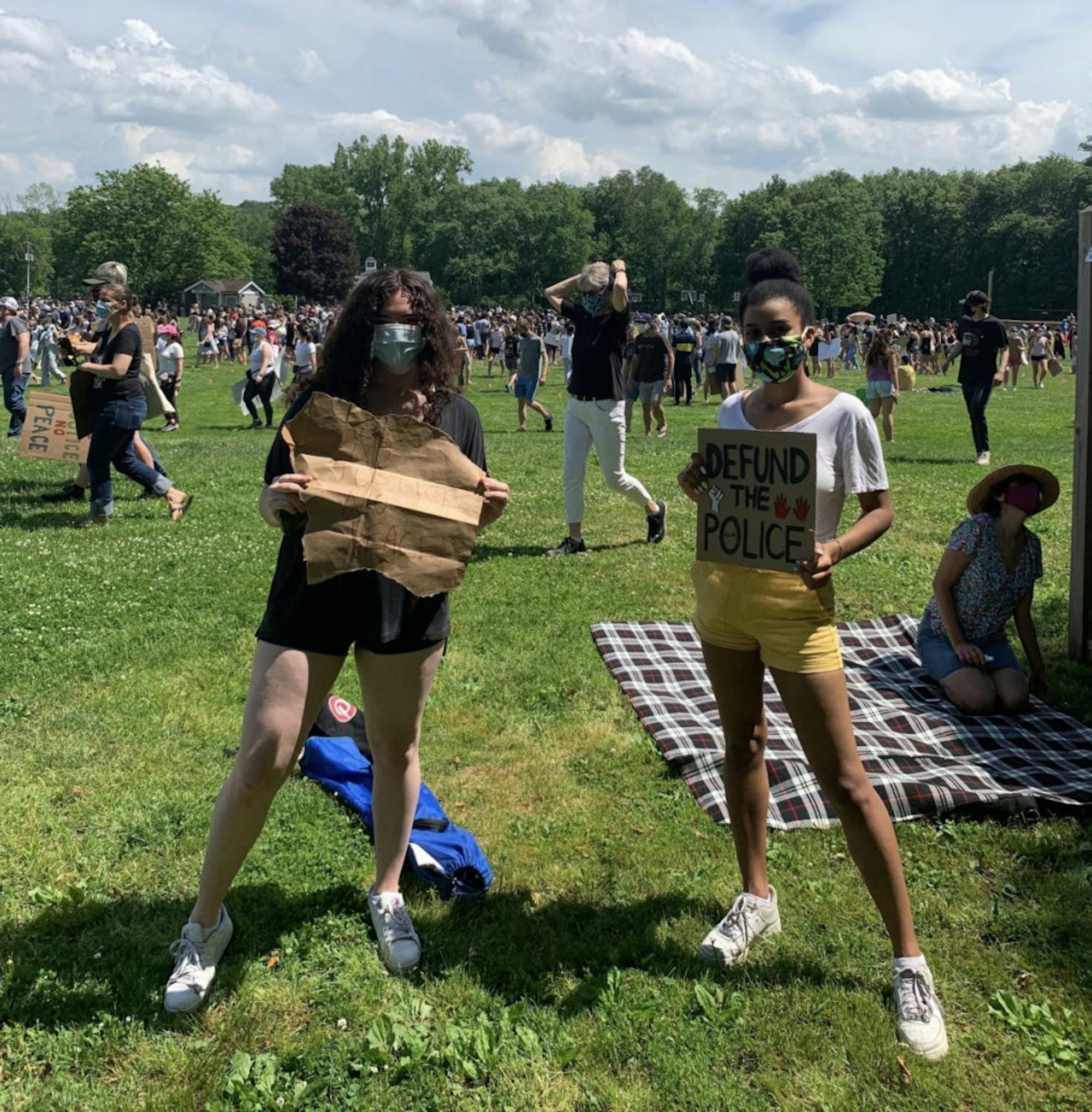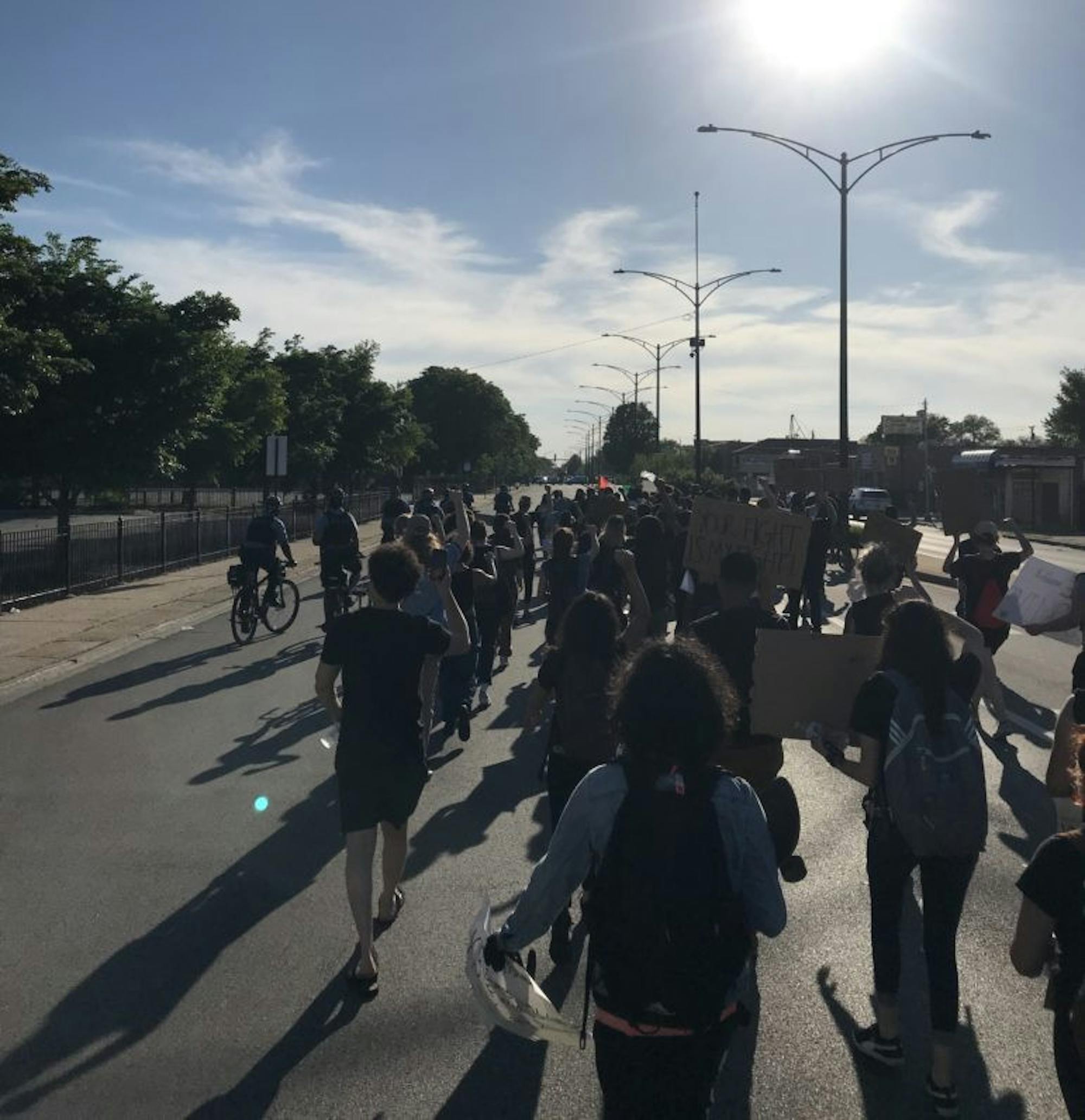Ayesha Chowdhury ’23 was shocked to see newspapers swell with updates about her hometown. Amelia Chikota ’22 said that seeing her town protest made the Black Lives Matter movement feel closer to home. Caitlin Stanton ’20 hears both chants for justice and evening cheers for frontline workers from her Manhattan window.
Dispersed across the country, Cornell students had just submitted their last final exams and papers from their childhood bedrooms when protests first sprang up in Minneapolis.
Now, in the weeks following George Floyd’s death, Cornellians are protesting in their hometowns, as demonstrations continue in all 50 states. They’re marching through the city streets that raised them, chanting “No justice, no peace.” They’re attending small-town rallies in their local parks. From Minnesota to New York, they’re fighting against police brutality and systemic racism, urging their communities to change.
Chowdhury, who has lived in Minneapolis for most of her life, said she’s never seen her city like this before. As she marched with the crowd through Lake Street twice last week, lingering tear gas burned in her eyes. The air smelled like fuel, and ashes from still-burning buildings floated past her. During the first few days of protest, she passed the George Floyd memorial each morning when she drove her mom to work.
“The memorial is beautiful. It’s huge. You feel its magnitude,” Chowdhury said. “It is surreal to be out there. I have never experienced anything like this, not even with the past protests. The magnitude doesn’t compare. People are done. They’re enraged. They’re tired.”
Wearing two face masks and holding a sign that read “Resist,” Chowdhury marched and felt her community grieve and pray. She saw mothers crying. She passed colorful murals covered with burn marks. She said driving to the protest was “a little thrilling.”
“You’re part of a movement,” Chowdhury said. “There’s both excitement and anxiety.”
When she arrived at the protest, which she called “so insanely peaceful,” Chowdhury couldn’t chant at first because she was emotionally overwhelmed.
She said she was initially heartbroken when she saw the murals and businesses in ruins, from the local FedEx to auto repair shops. But as she researched this destruction and spoke to her friends who live in the area, Chowdhury said she realized the long-term impact far outweighed the short-term damage.
“One of my friends said, ‘I am OK with my city burning if it means there will be justice.’ It’s gonna be worth it,” Chowdhury said. “People have had enough and they’re tired and they’re ready for the fight.”
“I feel like I’m watching a whole show,” she continued. “I’m not just at a protest. I feel like I’m at some kind of theater, almost. We’re walking around, and then there’s a huge speech. A reverend has something to say or someone who knew George Floyd has something to say. A 7-year-old also gave a speech. It’s sitting, it’s walking, it’s listening.”
When the throng of protesters arrived in front of a police precinct, Chowdhury swayed with demonstrators of all ages and races, as they sang John Lennon’s “Imagine.” Hundreds also poured downtown solely to clean up and help the community, Chowdhury added, as some people distributed water and juice boxes, telling protesters who marched by to stay hydrated.
“This is the most peaceful thing I’ve seen in a very long time,” Chowdhury said. “Our Cornell dining hall is more a mess than walking through those streets, protesting for equality, for change.”
‘Small demonstrations can create a bigger change’
Organizers across the country are initiating peaceful protests in their communities, including in New York — where a quarter of Cornell students are from — and even in predominantly white suburbs. Many of these towns have not previously mobilized against racial injustice in recent memory.
Chikota, who lives in Westchester County, said the rally she attended in Bedford, New York, created a platform for the community to hear stories about racism and discrimination that local schools haven’t always listened to or elevated. In her hometown of Chappaqua, high school students held Black Lives Matter signs on a street corner, as cars that drove by honked in support.
The hundreds of Bedford demonstrators heard speeches from candidates for local office and listened to stories that resonated with Chikota. The community heard from a young woman who switched schools after being the only Black girl in her classes throughout elementary and middle school.
“I had never really been able to discuss that with other people in Chappaqua because I would be the only Black girl in my class,” Chikota said. “It was helpful to hear that I’m not alone and that other people had gone through similar experiences in this area. I felt a sense of myself in her story.”
These protests against police brutality and injustice, though smaller, are important and distinctive, Chikota said. Her community and other towns across Westchester County are showing up and reckoning with white privilege. For Chikota, small rallies and vigils feel especially meaningful, considering that for years her predominantly white town fought against building affordable housing, a development that would welcome more racial diversity.
“It’s important even to have those few people, because people who might not have thought about protesting before will drive by and see,” Chikota said. “Small demonstrations can create a bigger change. It sets off something in our minds that’s like, ‘Oh, people actually care about this. Maybe I should care about this too.’”
‘I really can’t name a more empowering experience’
Tavo Duarte ’23 hasn’t heard of protests happening over racial injustice in his neighborhood in the South Side of Chicago since the 60s, when demonstrations broke out over school segregation policies.
Now, Duarte said that marching through his neighborhood streets last weekend gave him an outlet to release anger that has been building inside of him over systemic discimination. He also said he was protesting for those who did not have the privilege to protest.
Surrounded by police wearing riot gear, Duarte said he and the other protesters paused for a water break in the middle of a busy intersection in a call for autonomy.
“When we paused for a water break, we chanted, ‘Whose streets? Our streets!’” Duarte said. “After chanting that it's kind of impossible not to want to relish such a moment where you’re stopping literally all the traffic in one of the most inconvenient places.”
After marching and chanting in his neighborhood with a crowd of about 100 protesters last Saturday, Duarte joined a second protest in a nearby affluent community the following day, which drew around 500 people into the streets.
“I did a lot of reflecting as to why there were no bookstores in my neighborhood, and why I have to go to a wealthier community to have access to books,” Duarte said. “I felt very much like I had to go to that one.”
As an ally, Duarte said that his role is often just to listen — a value that he said he learned as a Posse Scholar, a scholarship program that identifies and trains student leaders.
“My individual voice doesn’t need to be heard right now, but I was able to hear my voice echo with the other voices,” Duarte said. “There’s no immediate fix for generational trauma that comes with oppression that activists have to keep with them during these protests, but it was a sort of therapy for me. I really can’t name a more empowering experience.”
A similar catharsis of sound resounds in New York City, especially at 7 p.m., Stanton said, as New Yorkers lean over fire escapes and balconies to cheer for frontline workers. In the streets below, protesters chant past them, said the incoming engineering masters student, who attended a protest in Washington Square Park last weekend.
“It shows that we’re living in a world in crisis,” Stanton said. “We’re living in a pandemic, but we’re just fully visualizing the racial injustices that have been here for so long. By cheering, everyone is aware that we’re doing our best to move forward and make changes that will hopefully make our world a better place for ourselves and for future generations.”
In a country engulfed in protest and pandemic, with grief and rage boiling over in city streets and suburban parks, all of these student protesters felt the exhaustion of the moment.
Duarte said he left a Sunday protest after three hours, feeling mentally and physically spent; others in the crowd did the same. When Chowdhury returned home from downtown Minneapolis after shouting and crying and listening for six hours, she immediately showered and then collapsed from exhaustion.
“There’s moments protesting when I close my eyes. I’m so exhausted. My eyes sting,” she said.
“These are regular people trying to have a basic human right,” Chowdhury continued. “People only have one cause and they’re doing it with their heart.”

Across the Country, Cornellians Take to Streets in Hometown Protests
Reading time: about 9 minutes
Chowdhury stands in front of a building that burned down during early Minneapolis protests.
Chikota (right) and a high school classmate stand with signs at a Bedford, New York, rally.
Duarte marched through his neighborhood in the South Side of Chicago last Saturday.
Read More










